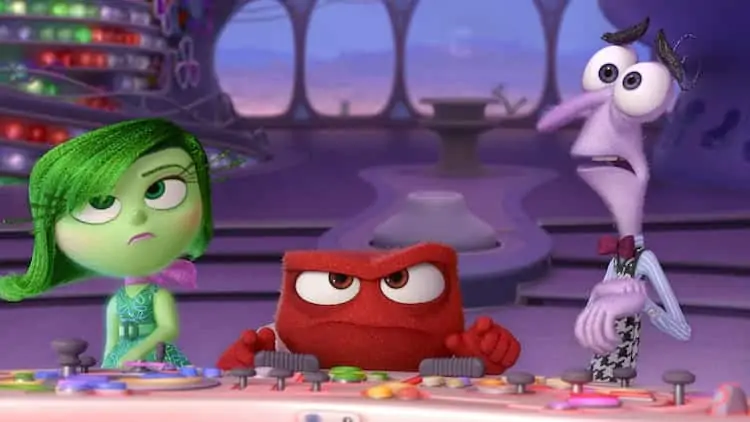From the beginning, Peter Docter loved the idea of going inside the mind, challenging the imaginations of many of the same filmmakers who took audiences to Monstropolis and later to South America in a house flown by balloons. The idea, he thought, was perfect for animation and ultimately, this idea of Emotions as characters sparked the story of Inside Out, Pixar’s fifteen feature length film.
A few weeks ago I had the opportunity to speak with Director Pete Docter and Producer Jonas Rivera as well as the films’ cast. Having already screened the film, what fascinated me the most were the characters and I just had to know how they were developed.

WHY FIVE EMOTIONS?
Docter explained that in his original pitch he brought up “Optimism” as a potential lead character for the film, however he later learned that that wasn’t an emotion, so Docter did was Disney and Pixar do best: Research. Known for the research they do—whether it’s becoming an expert in automotive design for Cars or trekking to Scotland to inform the breathtaking backdrop in Brave. The artists and storytellers behind immersed themselves in the mind, studying memories, human emotions and how they evolve during adolescence. When it came to which character Emotions to feature they learned that there is no consensus in the scientific community as to how many emotions a person has, but most place the number between 4 and 27. This was good news to Docter since it gave them so liberty to make it up. They arrived at 5 (Joy, Sadness, Anger, Fear, and Disgust) due, in large part, to the work of Dr. Paul Ekman, a consultant on the film, who back in the 70s posited 6 emotions – the Inside Out 5 plus “Surprise.” Docter felt “Surprise” as a cartoon was too similar to fear so that one fell to the wayside. The filmmakers felt that 5 was just a good odd number; not too much of a crowd that you would forget who was who, yet still enough to have conflict amongst the group.

WHAT DOES AN EMOTION LOOK LIKE?
Filmmakers now had to go about defining each Emotion, assigning them a purpose in Riley’s mind, and tackle the difficult process of finding the right look for each. “The look and design of the Emotions had to remind people that they are personifications of feelings,” said Docter. “They’re not little people. They’re Emotions. They’re made of energy—they’re made up of thousands of particles, which kind of looks like energy. We wanted to capture what emotions feel like—the shapes, the colors—as well as their personalities.” Determining the shapes and colors of each character was a rather abstract process. One of the Art Directors on the film came up with a great little drawing of shapes that essentially embodied each of the 5 Emotions. Joy was a Star, Sadness a teardrop, Anger a rectangular brick, Fear a tall straight line, and Disgust a stalk of broccoli. From there the look and appearance of each Emotion began to emerge. The colors, for the most part, corresponded to the emotions and shapes themselves, the only outlier being Fear where purple was chosen because that color was kind of leftover. As for Joy’s blue hair? As Docter explained, “originally it was orange and kept to the monochromatic scheme of each character, however we changed it to blue to make her standout as the main character, give her more dimension, and to foreshadow the idea that even though she doesn’t understand Sadness, she does have an element of it in her”.

WHAT DOES AN EMOTION SOUND LIKE?
Lewis Black was the first person the filmmakers had in mind as far back as the original pitch. So when the producers called him up to see if he was interested, his response fittingly was, “Great. Real ‘stretch’ casting guys. Brilliant.” Black described Pixar as having “psychotic humility” about them. In courting him, Black explains, they sent him a box containing every Pixar film and art book accompanied by a letter which said, “In case you don’t know who Pixar is…here’s a bunch of stuff.” Black, jokingly riffed that perhaps the studio thought he was “some sort of recluse,” but nevertheless Black was the first Emotion to be cast.
Bill Hader came onto the project pretty early too. A huge fan of Pixar, Hader requested a tour of their studio after the filmmakers visited SNL. They were there researching the process behind live television broadcasting which later helped them develop the Dream Productions sequence in the film. Afterwards, Hader flew out to the studio, had coffee with the filmmakers and was initially brought on to help write the film. In the process, Hader would try different voices for the various characters and his “Don Knotts of Mulberry” interpretation of Fear was liked so much that they asked him to play the role.
Casting Disgust was a struggle because they weren’t sure if she should be “disgusting” or “disgusted.” However once they settled on the later, Mindy Kaling’s name came up and she was cast.
Sadness early on was male, but as the script and story developed they realized there were too many male characters in a film that takes place in the mind of a young girl. So they switched the gender and it was at about that time that Producer Jonas Rivera saw Phyllis Smith in Bad Teacher and thought that the hesitance in her speech would be a great fit and play well for Sadness since prior to that, the character was written as a cry-baby. Phyllis Smith was called in and offered the role.
Joy was the last to be cast. Throughout the development process, she was the hardest to write for because she has a tendency to get very annoying, considering that she is always chipper and upbeat all the time. Amy Poehler was able to bring enough nuance to the character that she instantly became entertaining to watch and someone to root for.
Hopefully with these insights you’ll love the newest characters in the Pixar family as much as I did. Don’t forget to catch the film in theaters June 19th!